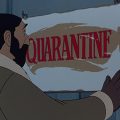Quarantine Control #50: Visions of V.I.L.E. Henchmen

We have somehow made it to the 50th Quarantine Control post, a milestone none of us assuredly wanted to reach. This ongoing feature was started as a way for Damage Control’s writers to document what we were watching, playing, reading, or listening while being further confined to our living spaces thanks to the COVID-19 pandemic. Not even the largest pessimists predicted we would be at it for quite this long. But this was bound to happen given the depths of depraved inanity key groups of people are willing to sink to, especially in the United States. Those include people in power who are still trying to escape blame for not taking the pandemic seriously, and others who wanted people to die from it.
Better times are on the horizon with the vaccine rollout and a president who gives a damn, but we’re still here right now.
Joseph Daniels
Carmen Sandiego has had a very interesting history, in both video games and on television. She’s one of my favourite villains of all time. There’s something I’d like to recommend watching this week, but first I’d like to take a little bit of time to explore where this week’s recommendation came from.
Where In The World Is Carmen Sandiego? (1991)
Network: PBS
Episodes: 295
I will be referring to this show as World in this article.

In the edutainment boom of the 1980s and 1990s on PBS, various television shows were created that were intended to get viewers interested in various academic subjects. One of my favourites was Square One Television, which focused on mathematics. There was also Reading Rainbow, which promoted literacy, and Bill Nye the Science Guy, which promoted science.
In 1991, a new show debuted which was focused on geography. At the time, I was fond of game shows (I still am) and thoroughly enjoyed Classic Concentration, The Price is Right, Bumper Stumpers, Hollywood Squares, Hi-Q, Family Feud, the 1986 version of Chain Reaction, Supermarket Sweep, and I even watched Jeopardy! back then. Naturally, when a new game show debuted on PBS, I was more than eager to watch it.
One of my favourite things about World was the opening. See if you can figure out why I liked it.
Did you catch that? When Chief Lynne Thigpen introduced the show, she didn’t say “All these kids” or “All these children”. She called the audience “people”. Talk about starting off on the right foot, showing respect to your audience, both in the studio and at home, and treating them as equals.
How do you translate a computer game into a game show? It’s not as easy as you’d imagine. You Don’t Know Jack! did it wrong, as I’ve discussed before. World did it properly by respecting its target audience and probably by spending a lot of time making sure the show was fun to watch, fun to play, and loaded with content. Each question was informative, and the sketch comedy used to frame each question was very entertaining. I don’t remember a single episode that made me cringe, or made me want to change the channel, and that’s important when trying to educate your audience.
A lot of the success of the show should be credited to Rockapella, but they’re not the only ones. Greg Lee and Lynne Thigpen did a lot of the heavy lifting, too. It helps when everyone working on your show are career entertainers and know what they’re doing.
Although the computer game was just a straightforward chase around the world, the game show introduced segments that were brand new and tailor made for the format. The Chase, for example, is a rapid-fire multiple choice segment consisting of several questions usually pertaining to a small area of the world. The final question of the first round is a Final Jeopardy!-like question where players can wager up to 50 of their points and could actually lose points if they get the question wrong. The two players who scored the most would move on to round two.
The second and third rounds were created specifically for the game show. The second round had players try to find, in the proper order, the loot that got stolen, a warrant for the arrest of the criminal responsible, and the crook who stole the loot. The problem with this round was that there wasn’t any real way of knowing where any of these were and it was basically sheer luck that contestants would find any of these.
The third and final round had the winner of round two try to catch Carmen Sandiego by correctly identifying several locations on a continental map in 45 seconds. It was an exciting way to end an episode, but it maybe gave an unfair advantage to certain players by giving some of them the much more familiar North American continent to run around on and some of them the much less familiar African continent. Asia and Europe were crap shoots, especially with how suddenly the world changed during the taping of the first season.
The Union of Soviet Socalist Republics broke up at that time and a lot of new countries were born, leaving behind a somewhat smaller – but still the largest in the world – country called Russia. Much more notable to the show was the split of Czechoslovakia into two countries, an event which necessitated a change to the lyrics of the show.
Starting with season two, the show would include a disclaimer that the information contained was accurate on the day it was taped, and then give the date. No other game show does this, not even Jeopardy!, which itself has occasionally run afoul of the rapidly changing nature of information. I remember an episode where Final Jeopardy! asked about the sixth Great Lake. It was the May 8, 1998 episode, and the category was Geography News. At the time it was taped, Senator Patrick Leahy had led an initiative to name Lake Champlain the sixth Great Lake, but after taping the episode, the US Senate decided that this was silly and rescinded the promotion, rendering the question obsolete before broadcast.
The series lasted for five seasons. It would then be replaced by…
Where In Time Is Carmen Sandiego? (1996)
Network: PBS
Episodes: 115
I will be referring to this show as Time.

To viewers like us, it seemed like PBS really screwed the pooch here. They had something everyone liked and they felt the need to change it. Well, it turned out that it was easier to get funding for a new show than it was to continue to get funding for a show that already existed, and so after five years, World was out and Time was in. Instead of keeping everyone from the original show and just reskinning it, the entire show was changed and everyone except for Lynne Thigpen were let go.
The first travesty was the brand new theme song. The original theme for World by Rockapella was creative and fun to listen to and to this day, the audience at their live shows shout out, “Do it, Rockapella!” The theme for Time was awfully generic with lazy lyrics and a forgettable tune, performed by three nobodies who no one remembers. There’s a reason exactly zero people still sing its theme song today.
The second travesty was the brand new set. The original set of World was meant to invoke the feeling of an old style detective agency. There weren’t a lot of bells and whistles and it was quite simple and easy to understand. Time’s set was too complicated, full of visual clutter that perhaps fit the notion of a time machine, but here’s the thing: the TARDIS was never this complicated and people got what Doctor Who was about just fine. And Bill and Ted traveled through time in an ordinary phone booth! There was no need to dress up the set of Time with more digital interfaces than the Next Generation USS Enterprise.
I have to hand it to Lynne Thigpen. She made the most of the change in format and I could listen to her lecture me on history all day, just as I could listen to her lecture me on geography. If she were alive today, I would hope that she’d be putting out a podcast because she was very good at delivering entertaining information.
And here’s the thing: the show followed the original format of World fairly close, enough that there was no reason to replace the rest of the cast and crew. The Data Boost is Time’s equivalent to The Chase and the Ultimate Data Boost is Time’s version of the Lightning Round.
Time’s second round consisted of a list of eight historical events and players had to put each of the events in order from most recent to the most distant in time. It’s honestly much more skill-based than the second round of World and was pretty much the only way Time improved itself over its predecessor.
The final round required players to make their way through six time portals in 90 seconds. Each time portal required answering a question correctly with two possible answers given. Getting a question wrong meant performing a physical task to open the gate. If the player could get through all six gates, Carmen Sandiego would be captured.
It seemed to me like a sufficiently quick player would be able to get two of the questions incorrect and still capture Carmen, possibly three if they were fast enough, unlike in World where players had to get a specific number of locations correct or they wouldn’t win. Perhaps Time was developed with the promise that more players would capture Carmen, since there were many episodes of World where players lost by mere inches.
Time debuted on my 14th birthday and it’s probably my least favourite birthday present I have ever received.
Time and World both aired at the same time as…
Where on Earth is Carmen Sandiego? (1994)
Network: FOX
Episodes: 40
I will be referring to this show as Earth.

I don’t know what was more surprising in researching this article, the fact that Time had two seasons before PBS realized no one liked it, or the fact that Earth only had a total of forty episodes. It had 40 episodes. That’s as many as four tens. And that’s terrible.
What’s terrible about it is that it lasted four seasons, but each season was short, even by today’s standards. The final season was also done very dirty by FOX since, true to their nature at the time, they lost interest in the series and spread out the airing of new episodes over the course of several years, beginning the airing of the final nine episodes in September of 1996 and ending it in 1999.
Earth featured a pair of ACME detectives named Zack and Ivy, pursuing Carmen Sandiego directly and often catching her henchmen and notorious VILE agents along the way. Whereas World and Time offered VILE agents with names like Double Trouble, Eartha Brute, Sarah Nade, Sir Vile, Medeva and Jacqueline Hyde, the evil agents in Earth sported such awful names as Frank M. Poster, Lars Vegas, Lee Galese, and probably the laziest name of them all, Al Loy.
Also, the series definitely got better over time. Whereas Zack and Ivy were summoned like computer characters in the first episode and acted like such, this was quickly dropped. Zack’s reluctance to use the C-5 corridor was also dropped after the first episode.
Another aspect which developed over time was Carmen Sandiego herself, gaining a bit of a character arc where it was revealed that she used to be a detective before turning to a life of crime, then finding herself in situations where she became a bit of an anti-hero even after giving up being a hero in the first place. She even occasionally worked with her rivals Zack and Ivy to bring a criminal to justice.
The series ended right after an episode where Carmen, having already been revealed to be an orphan in an earlier season, may have found her long lost father, which was a shame because if it had reached a fifth season, it would’ve been interesting to see where the series would’ve taken her character and whether the question of her parentage would’ve been revealed one way or the other.
Instead of Lynne Thigpen, the Chief in Earth was just a dollar store Max Headroom style computer avatar.
What I found most interesting about the characterization of Carmen Sandiego in Earth was that she went out of her way to make sure that Zack and Ivy were never in mortal danger, going so far as to either save them from mortal peril or only leave them in mild peril they could easily escape from. She was visibly pissed off in the episode Boyhood’s End, when former ACME agent Lee Jordan tried to murder Zack and Ivy in order to escape from them. She told him off quite angrily for pulling such a stunt, and then at the end of the episode, declared to the player that Lee did not have the maturity to be a good detective or a good thief.
Oh yeah, that’s another interesting aspect of the series. Earth seemed to treat each episode as a computer game that a young teenager was playing, and this unnamed Player communicated with Carmen directly, as if she was aware that she’s a game character. At first, Zack and Ivy seemed to be in on this, acting like computer characters during their introduction in the first episode, but by the next episode, they seemed to believe that they were real people. This lasted for the rest of the series despite that they regularly communicated with the Player and could instantly teleport all around the world, and briefly to the moon, thanks to the C-5 corridor. Carmen may or may not have been a real person as well, since she also communicated with the Player, but in one episode she suffered nightmares and told the Player that her next thefts were a matter of real life and not their game.
Carmen also typically left clues for Zack and Ivy, as if playing a game with them, too. It’s a very interesting dynamic which I enjoyed, since it helped to pace the episodes well and gave the series an excuse to deliver various geography (and occasionally history) lessons to the viewer, even delivering lessons about things that didn’t pertain directly to the case but were related thanks to a misinterpretation of the clue, or an interpretation based on incomplete information.
Earth was a good, albeit disappointingly short series… although it’s not the shortest series in the franchise.
As far as I can tell, although World had several international versions, there was only one international version of Time…
À la poursuite de Carmen Sandiego (1998)
Network: Ici Radio-Canada Télé
Episodes: Unknown
I will be referring to this show as Poursuite.

Yeah, this was pretty much the same as Time, with the same theme song (but with French lyrics) and although the Radio-Canada version of World built their own set, this version of Time used the exact same set as its English counterpart, moved up to Montreal. It also had at least one of the same villains as the English version, Jacqueline Hyde was the villain in the episode I watched on YouTube. There were more questions of Canadian historical significance in this version, too.
I find it interesting that “Data Boost” in French is “Survoltage” and the “Ultimate Data Boost” is “Mega Survoltage”.
Instead of Lynn Thigpen, this series featured Brigitte Paquette as the Chief, and even she was a better Chief of the ACME Detective Agency than the one from Earth.
Anyway, after Poursuite ended, there were no more new Carmen Sandiego shows made… until now.
Carmen Sandiego (2019)
Source: Netflix
Episodes: 32
I will be referring to this show as Netflix.

After an approximate twenty year hiatus from television, Netflix debuted a new Carmen Sandiego show basically titled “Carmen Sandiego”. Unlike World, Earth and Time, all of which asked where (or when) she was and were about pursuing and trying to capture her, this brand new reimagined continuity featured Carmen herself as the main protagonist, becoming a “white hat” thief, only stealing whenever it would harm VILE.
Various elements of the series were borrowed from previous incarnations. The Chief of ACME in Netflix was a brand new character named Tamara Fraser and was inspired by Lynne Thigpen from World and Time. Zack and Ivy returned from Earth, but instead of being ACME detectives, they were working for Carmen. Player returned from Earth as well, but in Netflix, he was a single person from Canada, a white-hat hacker using Player as an on-line username, rather than one of several young teenagers seen playing a game with Carmen in Earth. Tigress showed up as well, but was an entirely new character in Netflix instead of Ivy’s disguise in an episode of Earth.
I applaud Netflix for coming up with VILE operatives who had rather creative names. Perhaps they saw how horrible Earth was for names and put a little bit more thought into it. In any case, Netflix gave us operatives with names like Paper Star and Mime Bomb, and faculty members like Coach Brunt and Saira Bellum (the Netflix version of Sarah Bellum from Earth).
I love that there were also sly references to the past shows, like the elevator music in the episode Becoming Carmen Sandiego being the theme song from Earth. This was something they could get away with because the Earth theme song was closely based on an opera composed by Mozart.
I think the only truly disappointing aspect of this series was that it’s even shorter than Earth. Granted, it had a strong overall story arc, and I enjoyed that very little time was wasted in telling its story. I just wish that the series was at least as long as Earth.
Anyway, that was a relatively brief look at the Carmen Sandiego cinematic universe. I hope it was informative. I also hope you enjoy the 2019 series. And yes, I am planning on writing a review of it sometime soon.
See you next crime…
Geoffrey Barnes
WandaVision (2021)
Source: Disney Plus
Episodes: 9 (the entire first, and perhaps only, season)

WandaVision is a loose adaptation of a Marvel Comics saga that involved Wanda Maximoff and Vision, and the series was envisioned (pun intended) as a Disney Plus series before the pandemic started. But its concept just happened to be relatable. Our worlds are in perilous states, documented in the ledes of these 50 Quarantine Control entries and in the Marvel Cinematic Universe following the events of Avengers Endgame, and it would be a pleasure to remain in a created universe within our world for the time being. That’s largely what WandaVision is about.
Don’t take that as a big spoiler. Wanda and Vision are clearly stuck within a kind of sitcom given what occurred in previous MCU films and the time period in which it takes place. There was also no way that Marvel Studios and Disney would be brave enough to make a full-on sitcom spinoff with these characters inspired by older TV shows, let alone make it the first Marvel show on Disney Plus. It’s also easy to guess why Wanda would want to get away from it all given what happened in Infinity War. The key questions involve not only why they’re there, but who’s responsible. It’s thankfully not as predicable as expected.
It’s still a gutsy start for the MCU’s Disney Plus introduction. The first batch of episodes feature Wanda, Vision, and a series of new faces who live within the fictional town of Westview, New Jersey (though it wasn’t filmed anywhere in the actual state), with humor and presentation styles that switch between episodes to reference popular American sitcoms the past. The first one features humor inspired by The Dick Van Dyke Show, while the second is inspired by Bewitched (fitting considering who Wanda is). The third one takes after The Brady Bunch, this time in full color and widescreen but keeping the old-school style. There are enough clues to foretell what’s really happening here, but I feel like a contrarian by enjoying the episodes before the bigger reveal.
The hints don’t solely exist to show the viewer how there’s more to the show behind the scenes, but to convince the audience to stick around. The first clue appears early enough to prevent most viewers from dropping the show after concluding that the presentations aren’t for them, particularly younger MCU viewers who don’t “get” this type of humor. As it turns out, watching a bunch of Dick Van Dyke and Bewitched episodes as a child were good for something outside them generally being entertaining. The show works its way to the larger reveals at a solid pace.
WandaVision becomes a more conventional MCU showcase by the fourth episode, which occurs mostly outside the show within a show. Characters from previous MCU movies are reintroduced, like Agent Jimmy Woo (Randall Park) and Darcy Lewis (Kat Dennings) from the Ant-Man and Thor films, respectively, the latter of whom proves that she’s actually good for something. They come with an adult Monica Rambeau, following her debut as a kid in Captain Marvel. Despite knowing the old school humor well, I’ll admit to enjoying the first “real” world episode more than the previous ones. It’s from here that we start learning how WandaVision truly started, which went places I didn’t entirely expect.
Though it was always heading in a specific direction, it is a bit disappointing that WandaVision goes full MCU for its conclusion given the unique way in which it started. It ends with a typical fight between the purported forces of good and evil, with Marvel providing a lower-budget (but hardly low per se) version of a climactic movie fight to a TV show. There are even points where it ends up channeling Dragon Ball. It’s conventional, yes, but I’d be lying if I said I didn’t enjoy it even if the battle’s end wasn’t hard to predict.
It’s a damned shame that Monica Rambeau didn’t get much action considering who she is and has been in the comics. The show provides glimmers of her getting stronger, but she never gets to display anything close to her potential. There will absolutely be other opportunities for her to do so, I hope they don’t take long to get to them.
The few points where it falters aside, I very much enjoyed WandaVision. Its quality bodes well for the crowded future of the MCU on Disney Plus, where five more Marvel shows are set to debut this year alone, with the Falcon and the Winter Soldier starting tomorrow. Not every plot thread this series started was concluded, but whether they’ll all be resolved in other works or in a future season of WandaVision (despite it not being planned at the moment) remains to be seen. There’s no way they could reuse this precise concept again, but more can be done with its characters and others that could be introduced, especially when the MCU finally tackles the series from which Wanda originates.
There will be a day when the Quarantine Control series ends, but whether we’ll reach yet another sordid milestone before that happens is something only the flow of time can determine. We should all know better than to try to predict the future by now. Given everything the world’s gone through, and the steps some have taken to mitigate the spread of disease while others have been careless, reaching some kind of normalcy soon would be a pleasure.





